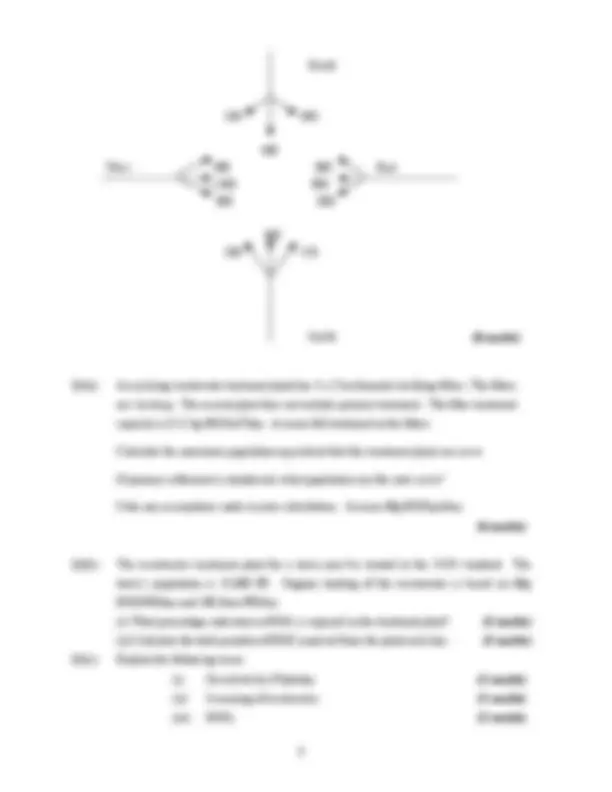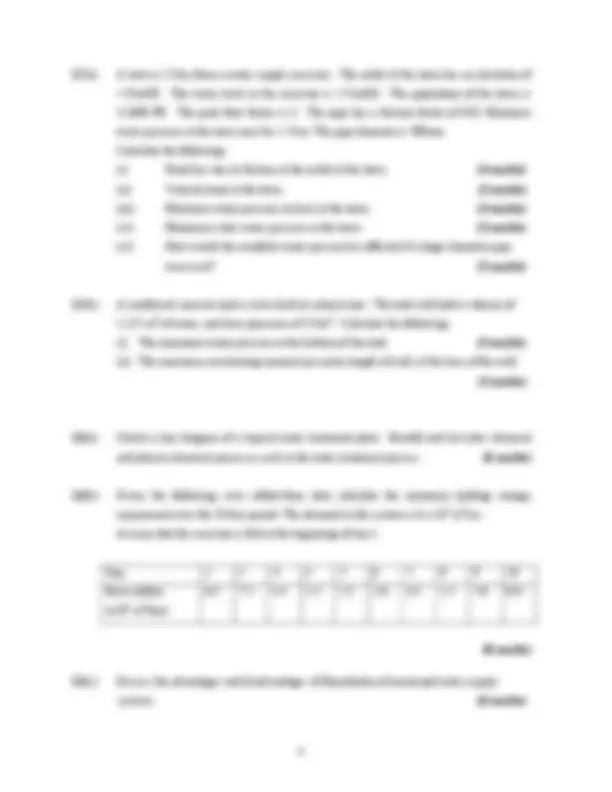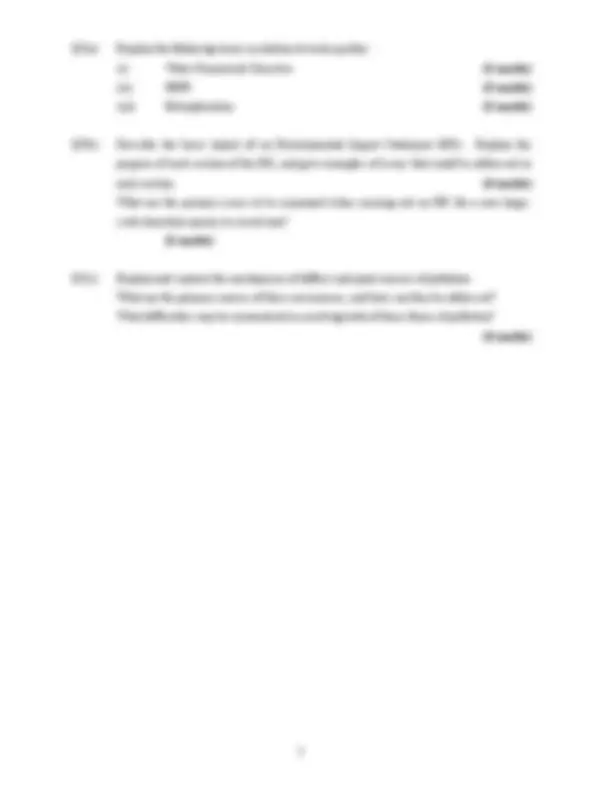





Study with the several resources on Docsity

Earn points by helping other students or get them with a premium plan


Prepare for your exams
Study with the several resources on Docsity

Earn points to download
Earn points by helping other students or get them with a premium plan
Community
Ask the community for help and clear up your study doubts
Discover the best universities in your country according to Docsity users
Free resources
Download our free guides on studying techniques, anxiety management strategies, and thesis advice from Docsity tutors
Main points of this past exam are: Rational Equation, Dillon Equation, Modified Rational Method, Calculate Rainfall Intensity, Calculate Peak Runoff, Manning’s Roughness Coefficient, Manning’s Equation, Water Quality Impacts
Typology: Exams
1 / 5

This page cannot be seen from the preview
Don't miss anything!




Instructions Answer 5 questions All questions carry equal marks.
Examiners: Mr. L O’Driscoll Mr. J. Kindregan Mr J. Lapthorne
Q1(a) Calculate the peak runoff from a 250m x 175m car park for a 10 year return period storm, and 30 minute duration. Use the Dillon equation (below) to calculate rainfall intensity. Use the Modified Rational Method to calculate runoff from the catchment areas. Assume 90% runoff from impermeable areas. Cr = 1.3. C (^) v = PR/100. (3 marks)
Dillon Equation (^35) p^15 t
Rational Equation Q(l/s) = 2.78.C (^) v.C (^) r. A(ha) I(mm/hr)
Calculate the design slope for a 400mm concrete pipe that drains this area, so that the pipe will be flowing half full at peak flow, using Manning’s Equation as follows: Q = A .R2/3^. S 1/2^ / n The Manning’s roughness coefficient is 0.013. (3 marks)
Q1(b) What hydrological and water quality impacts will be expected in a nearby stream which currently drains the area to be developed in Q1(a) above, following development? Explain methods which may be used to alleviate these impacts. (5 marks)
Q1(c) Explain the following terms with regard to rainfall analysis: (i) Tipping bucket rain gauge (3 marks) (ii) Intensity-Duration –Frequency relationship (3 marks) (iii) Hyteograph (3 marks)
Q2(a) With regard to waste management, discuss methods that may be used to reduce the following waste streams: (i) Construction and demolition waste (4 marks) (ii) Domestic hazardous waste (4 marks) (iii) Biodegradable waste (4 marks)
Q2(b) What are the advantages and disadvantages of thermal treatment of municipal solid waste? Why is this technology used as a method of solid waste management? (4 marks)
Q2(c) What are the important criteria used when selecting suitable landfill sites? Discuss mitigation measures, which may be taken to reduce any environmental impacts, which may be associated with landfills. (4 marks)
Q3(a) What are the three primary causes of fatal and injury road accidents in Ireland. Discuss methods that may be introduced to reduce fatalities. (6 marks)
Q3(b) Explain the methodology involved when conducting a manual traffic flow survey for a typical road in an urban area. Give typical examples of forms used. (6 marks)
Q3(c) The following traffic flows in pcu/hour were determined at a roundabout, based on traffic flow surveys. Is the roundabout capacity adequate (based on your analysis) given:
11m wide weaving sections, 42 m long in each quadrant, e 1 = 5m, e 2 = 10m
w
w w e Q
e = e^1 + e^2
Q5(a) A town is 15km from a water supply reservoir. The outlet at the town has an elevation of +25mOD. The water level in the reservoir is +57mOD. The population of the town is 15,000 PE. The peak flow factor is 3. The pipe has a friction factor of 0.01 Minimum water pressure at the town must be 1.5 bar. The pipe diameter is 500mm. Calculate the following: (i) Head loss due to friction at the outlet at the town (4 marks) (ii) Velocity head at the town (2 marks) (iii) Minimum water pressure (in bar) at the town (4 marks) (iv) Maximum static water pressure at the town (2 marks) (iv) How would the available water pressure be affected if a larger diameter pipe were used? (2 marks)
Q5(b) A reinforced concrete tank is to be built to retain water. The tank will hold a volume of 1,125 m^3 of water, and have plan area of 225m^2. Calculate the following: (i) The maximum water pressure at the bottom of the tank. (3 marks) (ii) The maximum overturning moment per metre length of wall, at the base of the wall. (3 marks)
Q6(a) Sketch a line diagram of a typical water treatment plant. Identify and describe chemical and physio-chemical processes used in the water treatment process. (6 marks)
Q6(b) Given the following river inflow/time data calculate the minimum holding storage requirement over the 10-day period. The demand on the system is 6 x 10 5 m^3 /sec. Assume that the reservoir is full at the beginning of day 1.
Day 1 2 3 4 5 6 7 8 9 10 River Inflow (x10^5 m^3 /day)
(8 marks)
Q6(c) Discuss the advantages and disadvantages of fluoridation of municipal water supply systems. (6 marks)
Q7(a) Explain the following terms in relation to water quality: (i) Water Framework Directive (3 marks) (ii) REPS (3 marks) (iii) Eutrophication. (3 marks)
Q7(b) Describe the basic layout of an Environmental Impact Statement (EIS). Explain the purpose of each section of the EIS, and give examples of issues that could be addressed in each section. (4 marks) What are the primary issues to be examined when carrying out an EIS for a new large- scale limestone quarry in a rural area? (3 marks)
Q7(c) Explain and contrast the mechanisms of diffuse and point sources of pollution. What are the primary sources of these occurrences, and how can they be addressed? What difficulties may be encountered in resolving both of these forms of pollution? (4 marks)